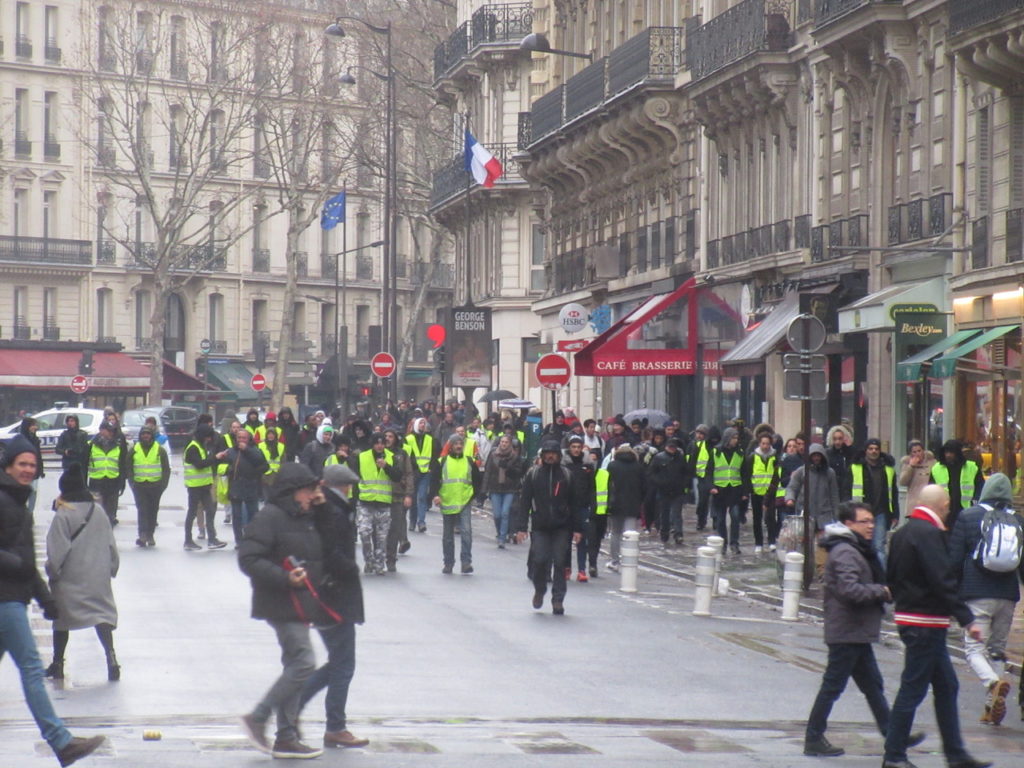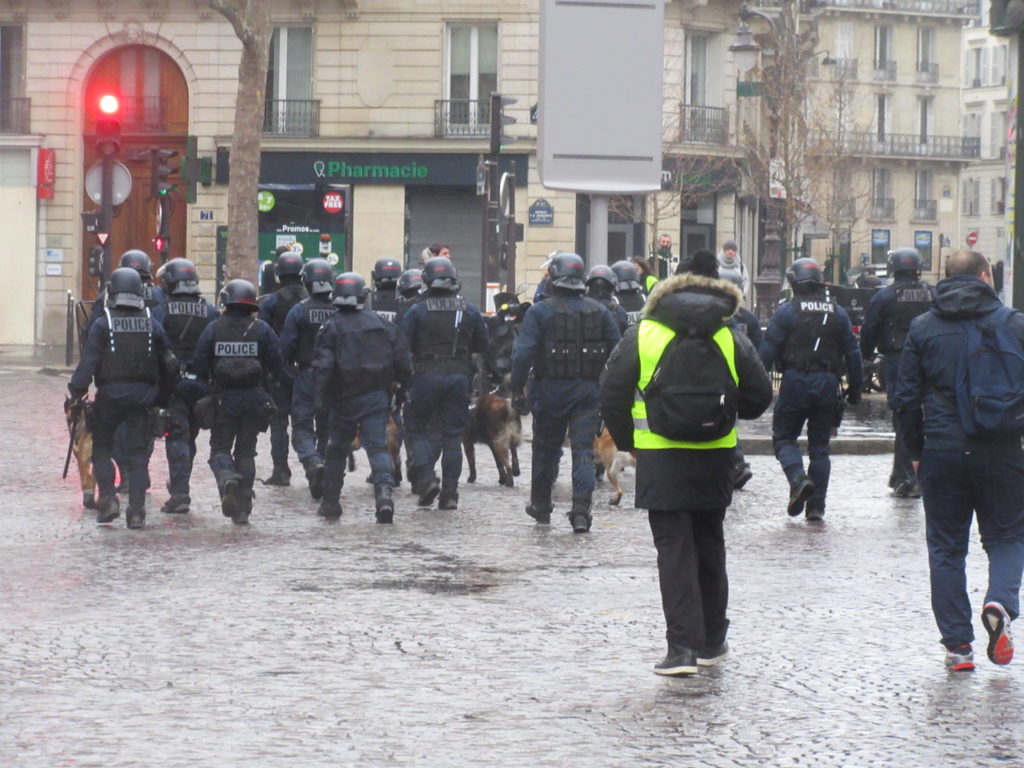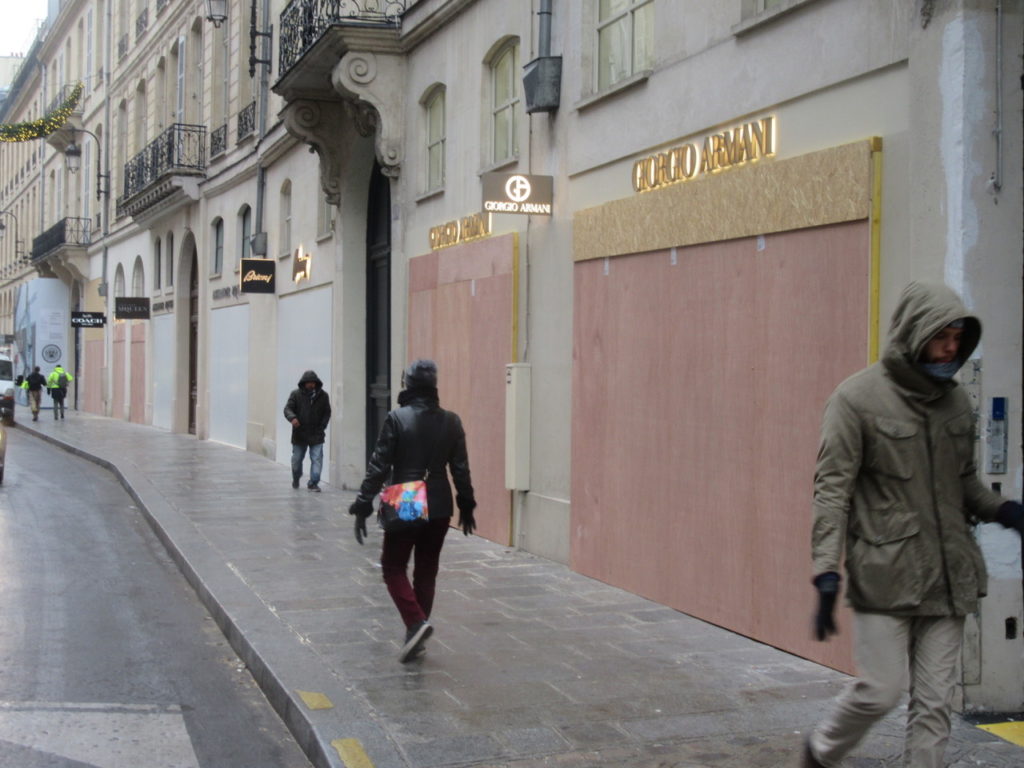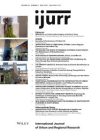Starting in mid November 2018, the gilets jaunes revolt has shaken France with a cascade of actions, including roundabout occupations, blockades and roaming demonstrations. The main actors: people who were initially only loosely connected to each other by the yellow jackets they wear and the social media they frequent. In early March, yellow vests are organizing themselves more formally in the form of electoral lists, popular assemblies and ongoing links to the organized labour movement. Yet the political colours of many “vests” are still uncertain, as are the political effects of their actions. This is a curious novelty of the gilets jaunes: they have an incredibly wide range of self-proclaimed supporters, encompassing parties, movements and intellectuals from the far right to the far left. This is true in France and in other places where the symbol of the yellow vest has become a political football.

Yellow vest protesters during a demonstration in Paris, December 2018. Photo: Stefan Kipfer.
In addition to these political attempts to claim the yellow vests, a veritable barrage of concepts has been launched to make sense of the revolt and its broader implications. Critics have mobilized terms from French history (“sans-culottes”, “poujadistes”) as well as concepts borrowed from elsewhere to grasp the revolt: E.P. Thompson’s “the moral economy of the crowd”, Chantal Mouffe and Ernesto Laclau’s “populism”, Michael Hardt and Antonio Negri’s “multitude”, W.E.B. Du Bois’s “wages of whiteness”, Ulrich Brand and Markus Wissen’s “imperial lifestyles”, and Antonio Gramsci’s “organic crisis”. As these conceptual search operations indicate, the gilets jaunes have defied the certainties of many researchers and strategists. Here, I offer a few preliminary observations about the still ongoing revolt, point to some intellectual implications, and hint at a few possible scenarios for the future:
1. The gilets jaune revolt opened as a critique of a proposed gas tax increase but quickly broadened to wider concerns about social injustice. Since the gas tax hike was withdrawn in early December, the main demands of the revolt have gravitated around fiscal justice (lower individual consumption taxes, higher taxes for the rich), redistribution (higher minimum wages, better public services), democratic participation, and, increasingly, freedom from state repression. Exclusively right-wing demands (against immigration, for authority) and anti-semitic conspiracy theories persist but have so far failed to define the main demands.
2. Judging by various early reports, the revolt is largely white and predominantly middle-aged as well as cross-class in character, with strong working-class and lower middle-class components and a significant minority of women participants. The revolt provides much food for thought for those interested in the meaning of class politics among unorganized fractions of the laboring population, who also experience distinctly gendered crises of social reproduction.
3. The revolt first emerged neither from central cities or postwar suburbs surrounding them but from the automobilized towns, exurbs, employment zones and shopping districts at the edge of and between the larger urban centres. The revolt defies any static political-geographic account of the relationship between political action and sub-, ex- or periurbanization (the processes that have produced spaces that in Euro-America are often seen as basing point of rightwing populism).
4. The revolt developed through a novel spatial dynamic of mobilization linking the main sites of occupation and mobilization (traffic roundabouts spread throughout the country) to blockades of infrastructure (highways, toll booths, ports, tunnels, refineries) and demonstrations in larger towns and cities held on Saturdays. This spatial dynamic will force us to return to the geography of uprisings and social movements and revisit the meaning of the “right to the city”.

Group of riot police officers during a yellow vests protest in December 2018. Photo: Stefan Kipfer.
5. The multifaceted spatial dynamic of mobilization also created points of contact between the yellow vests and other social forces, for example unionized workers and high school students from big-city suburbs and smaller towns. This and the unpredictability of the revolt has stimulated debate about the relationship between race and class, including debates in political antiracist circles about potential points of convergence between the gilets jaunes and those racialized as non-white.
6. The immediate effect of the yellow vest revolt was to stop a measure that Emmanuel Macron’s government claimed would address climate change: an increase in gas taxes. Some of the anger of the yellow vests has also targeted other means of regulating automobilized lives: toll booths and automatic radar controls. For those interested in political ecology and economy, these aspects of the revolt raise a thorny question: how to advance an egalitarian ecological transition in a world where ordinary lives are tied up in environmentally degrading systems and routines?
7. Similar to other movements since the Arab Spring, the yellow vest revolt expresses a deep crisis of political representation. Many protesters express a pervasive scepticism about organized politics and reject the distinction between left and right. In this respect, the yellow vest revolt resonates with other dismissals of the left-right divide: President Macron’s Bonpartism and Marine Le Pen’s neo-fascism. There are various lessons here for analysts of populism and the far right.
8. The yellow vests have widened the cracks within the French government and some state apparatuses. In early December, a whiff of insurrection was in the air, as the combined police forces failed to contain the many simultaneous and unconventional mobilizations. Also, the revolt interrupted Presdent Macron’s strategy to build a cross-partisan base to radicalize neoliberalism. If Emperor-Bonaparte Macron was already partly undressed in November, he is now without clothes. This fact will be of obvious interest to researchers of neoliberalism/neoliberalization as well as as those broadly focused on the extended state (political and civil society, following Gramsci) and the exercise of political rule.

Boarded store fronts in Paris during a yellow vests protest in December 2018. Photo: Stefan Kipfer
The gilets jaunes story is by no means finished. Even as some gilets jaunes are trying to structure themselves, one question remains glaringly, and at this point necessarily, unanswered. Who will benefit from this ongoing revolt and the crisis of political rule it has intensified? Will it be the generic tax-cutters and neoliberal populists in the government and further to the right? Will the far right manage to redefine “yellow” social demands as ethno-nationalist claims and garner electoral support from a revolt they don’t control but keep trying to infiltrate? Or will the gilets jaunes revolt help renew left-leaning subaltern political capacities, foster new social and political alliances and thus lay the foundation for a bulwark against both the neoliberal and the far right? The answers to these questions will have a significant bearing on the political conjuncture in France and Europe.
Stefan Kipfer, York University, Toronto
